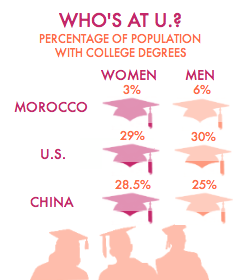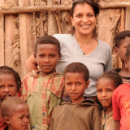
January 14, 2013 | Health and Well-Being, Violence Against Women
The Cut
How Julia Lalla-Maharajh is helping to end a controversial practice.

Julia Lalla-Maharajh with girls in Ethiopia.
Every year as many as 3 million African girls undergo a painful and dangerous procedure: the full or partial removal of their external genitals. Fortunately the nonprofit Orchid Project is helping to end Female Genital Cutting (FGC)—not only in Sub-Saharan countries but also in other locales where the practice is widespread, including Indonesia, Malaysia and Iraqi Kurdistan. Julia Lalla-Maharajh, who founded the Orchid Project in 2010, answers our questions from her home base in London.
What made you want to do this work?
I spent many years in London in the corporate world and I loved what I did. But then I decided I wanted to work as a volunteer.
It was in Ethiopia that I came across women and communities affected by female genital cutting. But the harder I looked, the harder it was to find anyone really concentrating on this issue or how to end it. It seemed to me that the realities of female genital cutting were not seen. FGC was perhaps one of most silenced, greatest taboos I had ever come across.
I felt that I had to do something. At that point I didn’t have a strategy or a way forward, but I started by taking the first step, and that was just to do whatever I could, to the best of my ability.
Tell us about the young girls who inspired you to start the Orchid Project.
I was travelling in the northern part of Ethiopia, in an amazingly spiritual place called Lalibela. There I met Megdes and Tinebab who were trying to sell me thousand-year-old bones of saints— which of course, were not real at all. But we spent time together and we played, them sneaking the bones into my pockets, with me expressing shock when I found them there. They were full of life and vitality. I wanted to beg their parents not to have them cut. But I knew I had no right to do that.
In that moment, I decided that I would do whatever I could. Little did I know it, but this vow ultimately led to Orchid Project. I think of Megdes and Tinebab often— are they married? Are they pregnant? When were they cut? What are their lives like? It is only a similar image of girls their age whose communities have chosen NOT to cut them that can override this one of Megdes and Tinebab.
Where is FGC most pervasive?
We support partners working in eight of the 28 African countries where FGC is practiced. One of our partners is Tostan, an NGO based in Senegal, whose respectful human-rights based program has led to thousands of communities abandoning FGC.
The highest prevalence of FGC is in the Horn of Africa, but the five countries with the largest populations of women affected by FGC are Ethiopia, Egypt, Nigeria, Sudan and Mali. However, we can’t even begin to factor in countries like Indonesia where there is little or no data.
Is it happening in the UK and the USA?
There is data in the UK that 66,000 women are affected by FGC and that 25,000 girls are at risk each year.
Is FGC a growing problem?
The answer is both yes and no! Yes: In areas like Indonesia, we are seeing worrying trends that are leading to an increase in cutting and to a wider acceptance of the practice. No: The rapid abandonment of the practice means that entire generations of girls are now not being cut, particularly in countries in West Africa. But it is possible that this millennia-old practice could end within a generation.
What is the worst thing about FGC?
It might be that it happens to girls as young as five years old. It might be that an uncut girl is considered an outcast. It might be the life of pain and infection and complications that it leads to. It might be that mothers feel they have no option but to cut their daughters. It might be how the repercussions are felt throughout a woman’s life. It might be that communities believe that it has to happen in order fora girl to be marriageable and accepted in the community. It might even be how it impacts entire communities – both women and men. It is really far too difficult to pull out just one thing!
What advice do you have for young women who want to change the world?
Start where you are! Literally take the first step and see where it takes you. Trust in yourself and your instincts. Examine your motivations and your intentions and make sure they are congruent with your principles. Seek out like-minded people but make sure you have at least one good critic. Take the first step and you may be surprised at what will follow.
What makes you optimistic?
Many things! Over 6,000 communities have now chosen to end FGC. There is an incredible momentum to this grassroots movement. Once communities explore their human rights, they are able to understand the impacts of FGC and abandonment is sustained and rapid. It really is an example of humanity at its best.